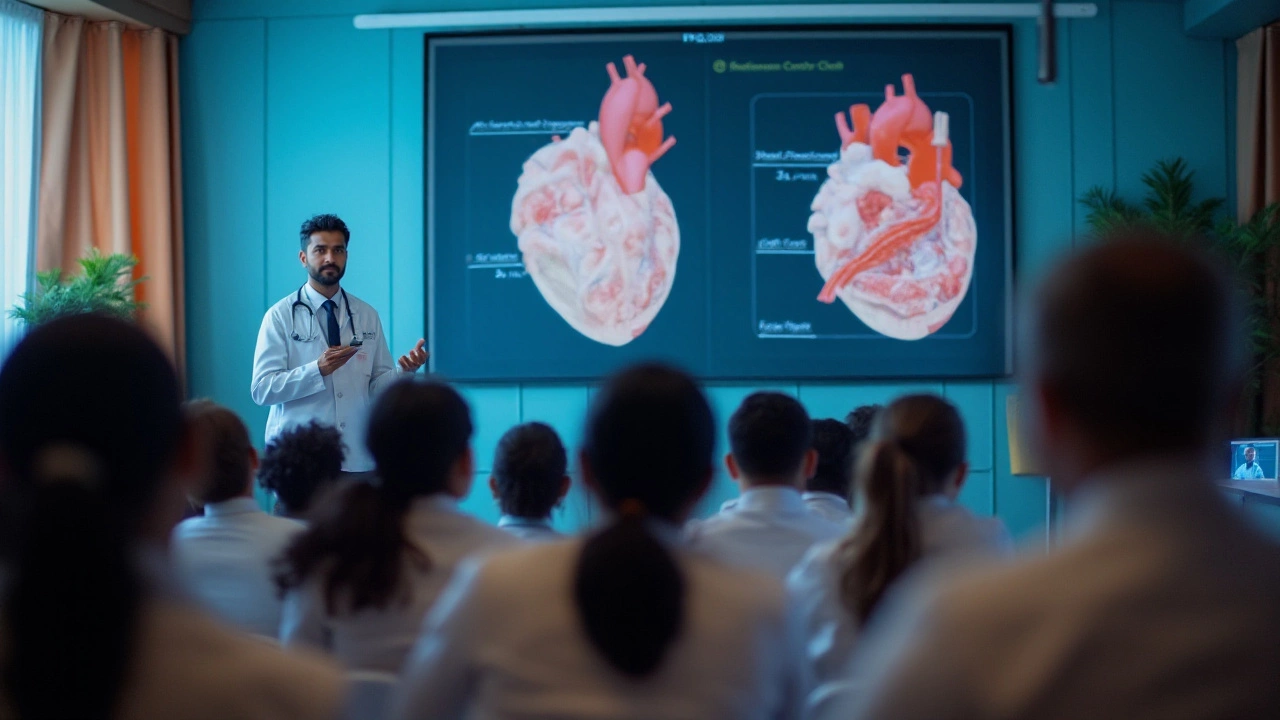Heart surgeries are a testament to modern medicine's ability to tackle some of the most life-threatening conditions. However, not all procedures are created equal in terms of risk. Some surgeries present significant challenges due to the complex nature of the heart and its functions. This article aims to guide you through three of the riskiest heart surgeries that patients may encounter.
The intricacies of each procedure, from heart transplants to coronary artery bypasses and the repair of aortic aneurysms, require meticulous planning and execution. Understanding the underlying risks and recent advancements in these surgeries can offer hope and clarity to patients and their loved ones. With this knowledge, making informed decisions becomes a more transparent process.
- Understanding High-Risk Heart Surgeries
- The Complexity of Heart Transplants
- Navigating the Challenges of Coronary Artery Bypass Grafting
- The Risks and Realities of Aortic Aneurysm Repair
Understanding High-Risk Heart Surgeries
High-risk heart surgeries stand out in the medical world due to the complexity and potential complications they carry. Physicians do not rush into these procedures without meticulous planning and deliberation. These surgeries often concern older patients or those with additional health issues, making the margin for error razor-thin. Surgeons must carefully balance the benefits and risks, taking into account not just the immediate dangers but the long-term implications for a patient's health. The heart, being the life force of our bodies, presents unique challenges when it comes to surgical intervention. The rich network of veins, arteries, and chambers must be managed with precision. Moreover, each patient's situation is unique, demanding a tailored approach that considers personal medical history and specific risk factors. Doctors are sometimes faced with difficult decisions, requiring them to weigh the patient's current quality of life against the potential for improvement through surgery.
The nature of these surgeries means they often require the most advanced technology and highly skilled medical teams. There is a significant reliance on cutting-edge equipment that can accurately monitor heart functions in real-time, making even minute adjustments possible during a procedure. Sophisticated systems enable surgeons to minimize invasiveness when possible, which is particularly important for high-risk patients who may not withstand traditional open-heart surgery. Another layer of complexity comes with the need for post-operative care. Recovery protocols are thorough and intense, ensuring patients regain full function and reduce the risk of complications. This includes careful monitoring for infections, blood clots, and other potential post-surgery issues that can arise due to the heart's critical role in overall body function.
On the flip side, advances in heart surgery techniques over the years have brought hope to many. Innovations like minimally invasive surgery and robotic-assisted procedures have improved outcomes significantly, even for those who would have been deemed inoperable not so long ago.
"The best surgeons are those who continuously learn and adapt to advancements in technology," noted Dr. Elena Bradley, a leading cardiac surgeon. "Our goal is always to improve patient outcomes with the least amount of intervention necessary."Despite these advancements, surgeons must inform patients of potential risks candidly. Discussions cover everything from anesthesia risks, potential for infection, heart failure, and the rare but possible occurrence of stroke or other critical complications during or after surgery. Families and patients must navigate this information carefully, often involving detailed consultations to ensure a complete understanding.

The Complexity of Heart Transplants
The heart, often romanticized as the seat of emotions, is in truth a marvel of biological engineering, and replacing it is among the most challenging tasks a surgeon can undertake. Heart transplants are typically reserved for patients suffering from severe heart failure when no other treatment options remain viable. The procedure itself involves removing the diseased heart and replacing it with a healthy heart from a recently deceased donor. This process is labyrinthine, requiring an intricate understanding of both the human body and advanced surgical techniques.
One of the primary complexities of heart transplants arises from the necessity of a match between donor and recipient. This goes beyond simple blood type compatibilities; it involves matching tissue types to minimize the risk of rejection. Rejection occurs when the recipient's immune system attacks the transplanted heart, perceiving it as foreign. This necessitates lifelong immunosuppressant medication, which itself carries risks like increased susceptibility to infections and certain cancers. The delicate balance of medication management is crucial, often requiring frequent adjustments.
The timing of the transplant is another intricate component. Once a heart becomes available, it must be transplanted within a limited window—ideally within four to six hours. This requires swift coordination between the transplant center, medical staff, and transport logistics. Surgeons and nurses must be ready at a moment's notice, often working through the night to ensure the heart is placed into the recipient as quickly as possible. This is a race against time where precision and efficiency are paramount.
Compounding the physical complexities are the psychological burdens faced by patients and families. Potential heart transplant recipients often endure long waiting periods, during which their health may deteriorate or they may face the emotional weight of uncertainty and hope. Recipients must also grapple with the enormity of receiving an organ from a deceased donor, which can result in feelings of gratitude mixed with guilt. Hospitals often provide psychological support to help navigate these complex emotions, aiding both patients and their families.
Moreover, innovations in transplant technology and technique continue to evolve. Advances such as ventricular assist devices (VADs) have been developed to temporarily support heart function while patients await a transplant. These devices can mean the difference between life and death for patients facing severe heart failure. Despite these advancements, the need for donor hearts still far outpaces availability, highlighting the importance of organ donation awareness campaigns.
The survival rates for heart transplant recipients have improved significantly, with many patients living ten years or more post-transplant. Yet, the road to recovery is long and requires a dedicated healthcare team. Recovery and rehabilitation after a transplant involve close monitoring to detect any signs of rejection early, as well as adherence to a strict regimen of medications. In the words of pioneering cardiac surgeon Dr. Christiaan Barnard, "The life you save may be your own." Heart transplants continue to push the boundaries of what modern medicine can achieve, offering a lifeline to those in the direst of circumstances.

Navigating the Challenges of Coronary Artery Bypass Grafting
Coronary Artery Bypass Grafting (CABG) is one of the most frequently performed heart surgeries globally, yet it is not without significant challenges. This procedure is often required when coronary arteries become blocked or narrowed, limiting blood flow to the heart muscle, which can lead to severe complications such as heart attacks. As such, CABG seeks to restore normal blood flow by grafting a healthy artery or vein from another part of the body around the blocked coronary artery. It is a meticulous and complex undertaking.
The risks associated with CABG largely stem from the underlying heart conditions that necessitate the surgery in the first place. Patients typically undergoing CABG have experienced severe arteriosclerosis, where plaque builds up in the coronary arteries. This condition not only complicates the heart's blood supply but can also affect the success of the grafting procedure. In addition, patient-specific factors, such as age, overall health, and the presence of other diseases such as diabetes, influence the risks and recovery outcomes. It's vital for patients to receive a comprehensive evaluation to determine whether CABG is the most viable option and to anticipate potential risks.
The procedure itself is rigorous, often requiring a heart-lung machine to take over the function of the heart and lungs while surgeons work. This machine sustains life during the surgery, which can last anywhere from three to six hours. The use of this machine, while life-saving, introduces additional risks such as neurological impacts or reduced cognitive function post-surgery. Surgeons are continually refining techniques to minimize these risks, but it's essential for patients to understand these possibilities.
Surgeons and medical teams must work in harmony to ensure positive outcomes. According to an experienced cardiac surgeon, "Close coordination and communication among the surgical team can significantly improve the success rate of the surgery and reduce the risk of complications." This insight highlights the importance of teamwork in such a high-stakes environment, where even a slight misstep could have serious consequences.
Recovery from CABG is another critical phase, one that demands patient vigilance and medical attention. Patients typically spend a few days in the Intensive Care Unit (ICU) for close monitoring before being moved to a regular hospital room. The post-surgery period requires careful management of pain, potential infections, and monitoring of the grafts. Physical rehabilitation is crucial to restore strength and function, making the recovery period demanding both physically and mentally.
Despite the inherent risks, CABG remains a life-saving operation for many, with impressive long-term outcomes when successful. The chance to alleviate symptoms like chest pain and improve quality of life is significant. Nonetheless, patients and families must engage in detailed discussions with their healthcare team to weigh the benefits against the risks, ensuring an informed decision-making process. New advancements in cardiac care continue to improve the procedures and outcomes of CABG, offering hope to those in need of this crucial intervention.

The Risks and Realities of Aortic Aneurysm Repair
When it comes to high-risk surgeries, few evoke as much caution as aortic aneurysm repair. An aortic aneurysm occurs when the walls of the body's main artery grow weak and bulge outward, forming a balloon-like structure. If left untreated, this can lead to life-threatening ruptures. Repairing an aneurysm is crucial, yet the procedure itself is fraught with risks and challenges. Depending on the aneurysm's location and size, different surgical approaches are taken, with open repair and endovascular repair being the most common. Open repair is the traditional approach, involving a large incision to replace the weakened section with a synthetic graft. Endovascular repair, meanwhile, is minimally invasive and entails using a stent-graft to reinforce the artery walls. The choice between these procedures often depends on the patient's health and the aneurysm's specific characteristics.
The complexity of these procedures can't be overstated. Open repair of the aorta requires stopping the heart and using a heart-lung machine, which adds significant risk. Patients undergoing this procedure face potential complications like respiratory issues, kidney damage, and infections. Alternatively, although endovascular repair reduces recovery time and risk of infection, it's not suitable for everyone due to its technical limitations in addressing particular types of aneurysms. Another layer of complexity arises when considering the long-term implications. Regular monitoring is necessary to ensure the graft remains intact and doesn't migrate, which could lead to further complications. Surgeons, therefore, need to carefully weigh the pros and cons of each technique against each individual patient's circumstances.
Statistics offer a stark view of the risks involved. Approximately 10-20% of patients may experience complications following aortic aneurysm repair. Common complications include bleeding, stroke, and issues related to the heart or respiratory function. Knowing these statistics can be daunting for anyone facing such surgery. Yet, with ongoing advances in surgical technology and techniques, the success rate of these procedures continues to improve. According to the Society for Vascular Surgery, the five-year survival rate post-repair has seen significant improvement over the past decade, which provides some reassurance to those needing this critical procedure.
"Our constant pursuit of enhancing minimally invasive techniques has bridged the gap in treating even the most challenging of aneurysms," states Dr. Matthew Eagleton in a feature for the Cleveland Clinic.Understanding the importance of monitoring pre- and post-surgery, doctors continue to advise regular screenings for those at risk, such as individuals with high blood pressure or a family history of aneurysms. This vigilance can often lead to early detection, which significantly improves outcomes. Preventative measures, lifestyle changes, and cutting-edge techniques all come together to shift the balance from risk to recovery.
For patients facing the reality of aortic aneurysm repair, information and preparation are key. Understanding why a procedure is recommended, its potential risks, and the recovery process can empower patients to make informed decisions along with their healthcare teams. Open dialogues with doctors, regular check-ins, and an awareness of potential symptoms lay the groundwork for better health management. Whether choosing an endovascular or open approach, being aware of the risks and preparing for them ensures that those undergoing this complex heart surgery are not doing so blindly, but with the full spectrum of modern medicine at their disposal.
